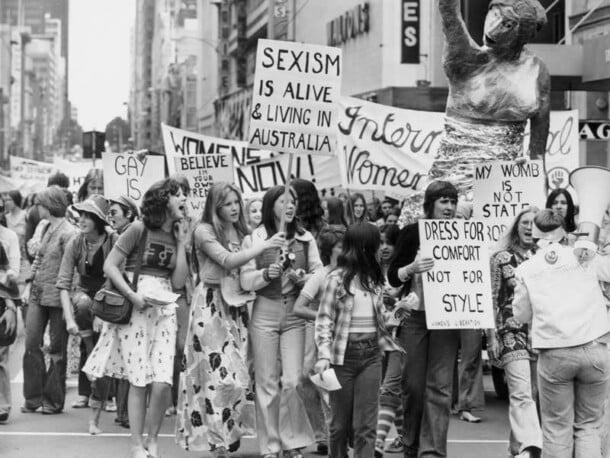Justine Clark sat down to write a brief introductory paragraph to our International Women’s Day email, but in writing the text took on a life (and length) of its own. Like many others, she is angry, sad and exhausted by the latest political scandals in Australia. It is impossible to separate IWD, and the “Choose to Challenge” theme, from the horrifying spectacle of a government unwilling to deal with entrenched sexism and a culture that endangers women. And architecture has a lot of work to do too!

Women on the march wave their placards at the International Women’s Day march, Melbourne, 8 March 1975. Australian Information Service photograph by John McKinnon. National Library of Australia.
Here at Parlour we usually have a pretty low-key approach to International Women’s Day. As I have declared in the past, ‘Every day is International Women’s Day at Parlour’. Often we simply roll up our sleeves and add more women to Wikipedia – and on Saturday 6 March we joined the Art+Feminism edit-a-thon in Melbourne.*
This year, my colleague Susie Ashworth suggested we get a bit more involved – and point those celebrating the day to the vast body of resources, advice and insight that Parlour has developed to support gender equity in the built environment professions. From the Parlour Guides to the Letters to my Younger Self, from data analysis to the recordings of Transformations and Light at the End of the Tunnel, from the Work and Wellbeing survey to the Home / Work series – we encourage everyone to use these resources as they work for gender equity every day of the year.
We also thought it was timely to commission an article outlining the origins of IWD. Anwyn Hocking obliged and has written an excellent overview of the day’s revolutionary beginnings, arguing that these provide an important basis for today’s advocacy and action. As she concludes, “armed with over a century of knowledge and progress, we have a solid foundation to continue demanding change. Indeed, the widening gender imbalances caused by COVID-19 have made our struggles to break down gender inequity this IWD all the more urgent for the lives of all women.”
Anwyn points out that the catchy IWD theme “Choose to Challenge” was in fact coined by a private group. The United Nations set a different theme – “Women in Leadership: Achieving an equal future in a COVID-19 world.” But the snappy slogan is more pervasive at events in Australia – and it makes me feel a little queasy. I have been thinking about why. It is the word ‘choose’ – as Susie comments, it is all a bit too “lean in”. It speaks directly to those already in privileged positions. What about everyone else?
Not everyone is lucky enough to be able to choose – many don’t have the economic or social or cultural security that must be in place in order to be able to take such a decision. Others have the capacity for choice brutally torn from them. If the events of this last week in Australian politics have shown us anything, it is that many, many women find themselves in challenging (not to mention dangerous) situations without ever choosing it. They become a threat to those in power, and that challenge is not welcomed. This is not restricted to politics. Architecture is not exempt. I have heard too many stories recently of harassment in practice – of women being asked to leave their jobs as their harasser’s career continues unaffected. This must be challenged – and it must be done collectively.
Of course, Choose to Challenge is intended as a positive call. Jess Murphy, convener of the Architects Champion of Change, articulated this well recently, when she urged the Champions to take the theme very seriously – to “be an upstander, not a bystander”, to not walk past or stand by, and to encourage and support others to do the same. Senior members of the profession can indeed make an enormous difference – and they have the capacity to choose to do so. But we must all also find ways to better support those who have little choice, or who become challenges to those in power without choosing that position.
At Parlour, we often point out that everybody has agency, but that we don’t all have the same type of agency. Some of us are well placed to challenge; others find leverage in more subtle ways. None of us can fix the problems of gender inequity single-handedly.
The origins of International Women’s Day are in collective action, and mobilising to create structural change remains an urgent project. Opportunities for women have taken an enormous hit during the global pandemic crisis, with some reporting that the “pink recession” will impact on women’s employment for decades. The United Nations theme draws attention to this challenge, while celebrating the extraordinary efforts of women from all walks of life.
“Women stand at the front lines of the COVID-19 crisis, as health care workers, caregivers, innovators, community organizers and as some of the most exemplary and effective national leaders in combating the pandemic. The crisis has highlighted both the centrality of their contributions and the disproportionate burdens that women carry.”
This is the theme that resonates for me. For those in Australia, let’s walk together at the Women’s March on 15 March.
Justine Clark is Director and co-founder of Parlour.
Note: The terms woman/women are used as inclusive of all women, and by extension girls, including cis-women, trans-women and intersex women.




















